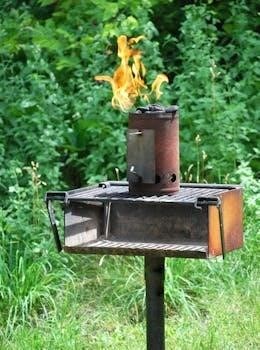Understanding your smoke detector manual is crucial for safety․ These guides provide essential information regarding installation and operation; They detail proper usage, ensuring optimal protection for you and your family․ Refer to it for manufacturer guidelines․
Importance of Understanding Your Smoke Detector Manual
Grasping the intricacies of your smoke detector manual is paramount for ensuring the safety and well-being of your household․ These manuals are not just collections of technical jargon; they are your primary resource for understanding the specific requirements and capabilities of your device․ They offer vital details on how to properly install the unit, where to place it for optimal effectiveness, and how to maintain it to ensure reliable operation․ Neglecting to read and comprehend your smoke detector’s manual can lead to improper installation, resulting in the system’s failure to detect fires effectively․ Moreover, familiarity with the manual enables you to identify common issues, such as low battery warnings or malfunctions, and take prompt corrective actions․ The manual also provides crucial information on what to do when an alarm sounds, including safety protocols and evacuation procedures․ By understanding your manual, you are not only ensuring the longevity of your device but also empowering yourself with the knowledge necessary to protect your home and loved ones from the devastating effects of fire․ Investing time in this understanding is an investment in your family’s safety․

Overview of Key Sections in a Typical Manual
A typical smoke detector manual is structured to guide users through various aspects of the device, ensuring its correct installation, operation, and maintenance․ Key sections usually start with an introduction that outlines the importance of smoke detectors and provides safety precautions․ The installation section details the proper placement of the device, offering specific instructions on where to mount it for maximum coverage․ This section might also include wiring diagrams for hardwired models and battery installation guidance for battery-powered detectors․ A maintenance and testing section will explain how to regularly test the alarm and how frequently to replace batteries․ This area often includes cleaning procedures to keep sensors clear and efficient․ Furthermore, a troubleshooting section addresses common issues, such as false alarms, chirping sounds, and malfunctions, offering solutions and remedies․ Crucially, most manuals include a section on what to do when the alarm sounds, providing instructions on evacuation procedures and contacting emergency services․ Understanding each section of the manual allows users to effectively use and maintain their smoke detectors, ensuring optimal performance and home safety․ Familiarization with these sections is key to proactive fire prevention․

Installation Guidelines
Proper installation is key to effective smoke detection․ Follow the manual’s guidelines for placement, ensuring optimal coverage․ Refer to wiring diagrams for hardwired models․ Battery installation instructions must be carefully adhered to for proper functionality․
Proper Placement of Smoke Detectors
Strategic placement of smoke detectors is paramount for early fire detection․ Install detectors on every level of your home, including the basement․ Avoid placing them near windows, doors, or vents where drafts could interfere with smoke detection․ For optimal performance, position detectors in hallways and near sleeping areas, ensuring that alarms can be clearly heard․ Consider installing a detector inside each bedroom if sleeping areas are dispersed․ Ensure detectors are mounted on the ceiling or high on the wall, as smoke rises․ Do not install smoke detectors in kitchens or bathrooms due to the possibility of false alarms from cooking fumes or steam․ Follow the manufacturer’s recommendations for specific placement in your manual, and keep in mind any unique factors of your home’s layout․ Regularly check the functionality of each detector after installation․ Always follow local building codes and regulations for smoke detector placement, as they may have additional requirements․ By following these guidelines, you maximize the effectiveness of your smoke detectors and improve your family’s safety․
Step-by-Step Installation Instructions
Before you begin, carefully read your smoke detector’s manual․ Turn off the power at the breaker if installing a hardwired detector․ Locate the mounting bracket included with your device․ Using the provided screws, securely attach the bracket to the ceiling or wall․ For battery-powered units, insert the batteries according to the polarity markings․ Now, align the smoke detector with the bracket and twist it into place․ Ensure it’s firmly attached․ For hardwired devices, carefully connect the wires according to the manual’s wiring diagram․ Verify the connections are secure․ Once installed, test the smoke detector by pressing the test button․ A loud alarm should sound․ If it doesn’t, check the power source and connections․ Repeat this test after installing each detector․ If your detector does not sound correctly, review the instructions again․ Do not proceed to the next step if the test is unsuccessful․ Always consult your manual for specific installation details․ Following these steps carefully ensures proper installation for optimal safety and functionality․
Wiring Instructions for Hardwired Detectors
Before commencing wiring, ensure power to the circuit is completely off at the breaker box to prevent electrical shock․ Consult your smoke detector’s manual for the specific wiring diagram, as it may vary between models․ Typically, you’ll find three wires⁚ black (hot), white (neutral), and a ground wire (usually bare copper or green)․ Connect the black wire from your home’s electrical system to the black wire on the detector․ Then, connect the white wire from your home to the white wire of the detector․ Secure the ground wire to the green screw or bare copper wire on the detector’s mounting bracket․ Use wire nuts to firmly join each connection, ensuring no bare wire is exposed․ Be certain that each wire is securely connected with no fraying․ After completing all connections, carefully tuck the wires into the junction box․ Mount the detector to the bracket securely․ Finally, restore power and test the alarm by pressing the test button․ If the alarm doesn’t sound, recheck your connections and consult your manual for troubleshooting guidance․

Maintenance and Testing
Regular maintenance and testing are essential for reliable operation of your smoke detectors; Consistent checks ensure they function correctly․ This includes battery replacement, cleaning, and routine testing, following the guidelines in your manual․
Regular Testing Procedures
Consistent testing of your smoke detectors is paramount for ensuring their proper functionality and your safety․ The recommended frequency for testing is typically at least once a month, but refer to your specific manual for precise instructions․ Most detectors are equipped with a test button, which, when pressed, should activate the alarm sound․ If the alarm does not sound, or if the sound is weak or inconsistent, it indicates a potential problem requiring immediate attention, such as a battery replacement․ It is crucial to follow the manual’s guidelines to avoid false alarms or improper testing․ During each test, ensure that the alarm sound is loud and clear throughout the home․ If you have interconnected detectors, verify that all of them sound when one is tested, indicating the entire system is operating correctly․ By adhering to regular testing procedures, you significantly enhance the reliability of your smoke detection system․
Battery Replacement Guidance
Timely battery replacement in your smoke detectors is essential for maintaining their effectiveness․ Smoke detectors typically use either standard alkaline batteries or lithium batteries, and the type required varies based on the specific model, so always consult your manual․ Most detectors emit a low battery chirp to signal the need for a change, often lasting for approximately 30 days, giving you time to act․ When replacing batteries, always use the specified type and ensure they are installed correctly, matching the polarity markings (+ and -)․ After installing new batteries, test the detector to confirm it is functioning correctly․ It is also recommended to replace batteries annually as a preventative measure, even if the low-battery signal hasn’t been triggered, and it is good to note this on your calendar․ Keep spare batteries on hand to make the replacement process easier․ Failing to replace batteries can render detectors ineffective during emergencies․
Cleaning and Maintenance Tips
Regular cleaning and maintenance of smoke detectors are vital for ensuring their optimal performance and longevity․ Dust and debris can accumulate within the detector, potentially hindering its ability to sense smoke particles effectively․ To clean your smoke detector, gently vacuum the exterior using a soft brush attachment, paying close attention to the vents and openings․ Avoid using liquids or sprays directly on the detector as they can damage the internal components․ Do not use abrasive cleaners or solvents․ Check for any signs of damage or corrosion during cleaning; if found, replace the detector․ Some models may require additional cleaning of internal parts; consult your specific manual for instructions․ Regular cleaning and maintenance will keep your smoke detectors working efficiently, providing reliable protection against fire hazards․ Always ensure the power is turned off before any cleaning․ Regular checks are essential․

Troubleshooting and Safety
Addressing common issues and understanding safety procedures are key aspects of smoke detector ownership․ Familiarize yourself with troubleshooting steps for false alarms and the appropriate actions to take when an alarm sounds․
Common Alarm Issues and Solutions
Smoke detectors, while crucial for safety, can sometimes present issues that may cause confusion or concern․ One common problem is the occurrence of false alarms․ These can often be triggered by steam from showers, cooking fumes, or even dust accumulation․ In such instances, it’s important not to disable the detector but to investigate the cause․ Cleaning the detector’s vents with a vacuum cleaner’s brush attachment can help remove dust․ Another frequent problem is a chirping sound, which typically indicates a low battery needing replacement․ Ensure you’re using the correct type of battery, as specified in the manual․ If the issue persists after battery replacement, check for any obstructions or damage to the detector․ Some models may have a reset button; refer to your manual for its location and how to use it; Furthermore, if you have hardwired detectors, consult the wiring instructions in the manual for any possible wiring issues․ It’s vital to address any issues promptly to maintain the detector’s functionality and ensure your safety․ Remember that overriding the alarm is not recommended․
What to Do When an Alarm Sounds
When a smoke detector alarm sounds, it’s imperative to act quickly and calmly․ First, immediately evacuate the premises․ Follow your predetermined escape plan and ensure everyone in the household is accounted for․ If possible, crawl low to the ground to avoid smoke inhalation․ Do not stop to collect belongings; your priority is to get out safely․ Once outside, call the fire department from a safe location․ Do not re-enter the building for any reason until the fire department has given the all-clear․ If you are unsure whether the alarm is genuine, treat it as if it is․ If the alarm continues to sound after you have evacuated and the fire department is on its way, do not attempt to disable or investigate further․ Be aware of the signals from your detector, they could be related to the alarm system․ Remember, a quick response can make all the difference in protecting yourself and your family․ Familiarize yourself with your escape route, and ensure everyone in your home is aware of it․
Understanding Alarm Signals and Indicators
Smoke detectors use various signals and indicators to communicate their status, and understanding them is vital for effective safety․ A loud, continuous alarm typically signifies the presence of smoke, demanding immediate evacuation․ Some detectors also incorporate visual indicators, such as flashing lights, which can provide additional information about the alarm’s condition․ A chirping sound usually indicates a low battery, prompting the need for a replacement․ Different patterns of beeps and flashes may point to specific issues, like a detector malfunction or the need for maintenance․ Refer to your device’s specific manual to understand these unique signals․ Familiarizing yourself with these distinct indicators can help you differentiate between a genuine fire emergency, a low battery warning, or a fault with the device․ It’s crucial to know what each signal means so you can respond appropriately․ Regularly check your detector and consult the manual to ensure you can effectively interpret its warnings․ Ignoring these can have serious consequences, so be aware of the signals and indicators․
